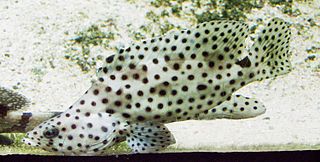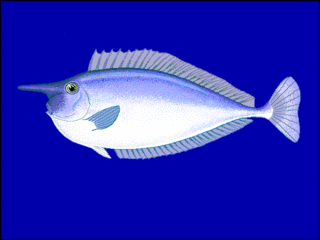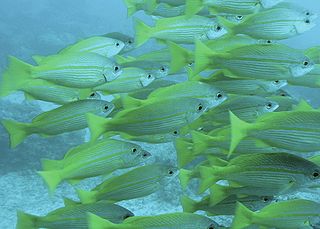
The Serranidae are a large family of fishes belonging to the order Perciformes. The family contains about 450 species in 65 genera, including the sea basses and the groupers. Although many species are small, in some cases less than 10 cm (3.9 in), the giant grouper is one of the largest bony fishes in the world, growing to 2.7 m in length and 400 kg (880 lb) in weight. Representatives of this group live in tropical and subtropical seas worldwide.

Requiem sharks are sharks of the family Carcharhinidae in the order Carcharhiniformes. They are migratory, live-bearing sharks of warm seas and includes such species as the tiger shark, the bull shark, the spinner shark, the blacknose shark, the blacktip shark, the grey reef shark, the blacktip reef shark, the silky shark, the dusky shark, the blue shark, the copper shark, the oceanic whitetip shark and the whitetip reef shark.

Acanthurus is a genus of fish in the family Acanthuridae found in the Atlantic, Indian and Pacific Ocean. They are found in tropical oceans, especially near coral reefs, with most species in the Indo-Pacific but a few are found in the Atlantic Ocean. As other members of the family, they have a pair of spines, one on either side of the base of the tail which are dangerously sharp.

Chaetodon is a tropical fish genus in the family Chaetodontidae. Like their relatives, they are known as "butterflyfish". This genus is by far the largest among the Chaetodontidae, with about 90 living species included here, though most might warrant recognition as distinct genera.

Naso is a genus of fish in the surgeonfish family, Acanthuridae. Fish of this genus are known commonly as unicornfishes because of the "rostral protuberance", a hornlike extension of the forehead present in some species. Unicorn fish are popular with spearfishermen and may be cooked by grilling them whole. Unicornfish primarily live around coral reefs and eat mostly algae as well as roshi (flour) in Maldives. It is very popular in Maldives.

The Priacanthidae, the bigeyes, are a family of 18 species of marine ray-finned fishes. "Catalufa" is an alternate common name for some members of the Priacanthidae. The etymology of the scientific name refers to the family's very rough, spined scales. The common name of "bigeye" refers to the member species' unusually large eyes, suited to their carnivorous and nocturnal lifestyles. Priacanthidae are typically colored bright red, but some have patterns in silver, dusky brown, or black. Most species reach a maximum total length of about 30 cm (12 in), although in a few species lengths of over 50 cm (20 in) are known.

Holocentridae is a family of ray-finned fish, the only family of the order Holocentriformes. The members of the subfamily Holocentrinae are typically known as squirrelfish, while the members of Myripristinae typically are known as soldierfish. In Hawaii, they are known by the Japanese name mempachi/menpachi (メンパチ) or the Hawaiian ʻūʻū.

Haemulidae is a family of fishes in the order Perciformes known commonly as grunts. It is made up of the two subfamilies Haemulinae (grunters) and Plectorhynchinae (sweetlips), which in turn contain about 133 species in 19 genera. These fish are found in tropical fresh, brackish, and salt waters around the world. They are bottom-feeding predators, and named for the ability of Haemulinae to produce sound by grinding their teeth. They also engage in mutualistic relationship with cleaner gobies of genus Elacatinus, allowing them to feed on ectoparasites on their bodies.

Bodianus or the hogfishes is a genus of fish in the family Labridae found in the Atlantic, Indian and Pacific Ocean. These species have many parasites.

Myripristis is a genus of soldierfishes.

Plectorhinchus is a genus of marine ray-finned fish, sweetlips belonging to the subfamily Plectorhinchinae which is one of two subfamilies in the family Haemulidae which also includes the grunts. The species in this genus are found in fresh, brackish, and salt waters.

Scarus is a genus of parrotfishes. With 52 currently recognised extant species, it is by far the largest genus in this family. The vast majority are found at reefs in the Indo-Pacific, but a small number of species are found in the warmer parts of the eastern Pacific and the western Atlantic, with a single species, Scarus hoefleri in the eastern Atlantic. Most are very colourful, and have strikingly different initial and terminal phases. Adults of most species reach maximum lengths of between 30 and 50 cm (12–20 in), but the rainbow parrotfish can grow to lengths of 1.2 m (3.9 ft).

Lutjanus is a genus of marine ray-finned fish, snappers belonging to the family Lutjanidae. They are found in the Atlantic, Indian, and Pacific Oceans. They are predatory fish usually found in tropical and subtropical reefs, and mangrove forests. This genus also includes two species that only occur in fresh and brackish waters.

Ostorhinchus is a genus of ray-finned fish in the family Apogonidae native to the Indian and Pacific Oceans.

Gerres is a genus of mojarras found mostly in coastal regions from the eastern Atlantic Ocean through the Indian Ocean to the western Pacific. A single species, G. simillimus, is from the East Pacific. They mainly inhabit salt and brackish waters, but will enter fresh water. At least one species, Gerres cinereus, displays an ability akin to gyroscopic stability, allowing it to remain in a remarkably static spatial position relative to the water flowing around it.

Pomadasys is a genus of grunts native to the waters of the eastern Atlantic Ocean and through the Indian Ocean to the Pacific coast of the Americas. The name of this genus is a compound of poma meaning "lid" or "covering" and dasys meaning "rough", a reference to the serrated preopercle.
















